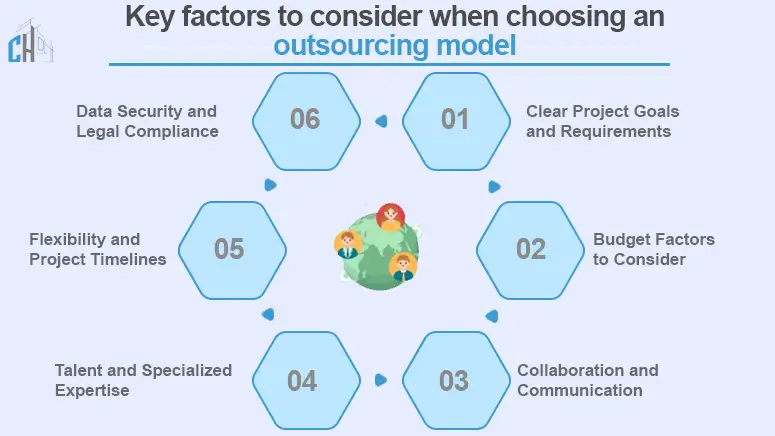
Outsourcing BIM modeling and architectural solutions has become a key strategy for businesses looking to meet rising demands, reduce costs, and access specialized skills.
Particularly as companies begin to scale, the right model. onshore vs nearshore vs offshore is a very important decision making aspect. They all have the benefits of their models, but if you pick the wrong one, you can run into unexpected issues.
With a company scaling, it becomes critical to choose the right outsourcing model, onshore, nearshore or offshore. Every model comes with its own set of advantages but picking the wrong one can lead to challenges which could have been avoided.
Having said that, several top firms like Archdraw Architects have struggled with these architectural BIM outsourcing services so far, mainly due to cost issues or communication gap in between. They lacked quality and were delayed when outsourced Architectural services were done offshore.
This again highlights the importance of differentiating the outsourcing models — onshore vs nearshore vs offshore — and keeping oneself at bay from this type of problems. This blog outlines all the types of outsourcing models so that you can choose the right one as per your business requirement.
There are different outsourcing models that you need to consider before planning outsourcing, which one suits your business more? In this blog we compare onshore vs nearshore vs offshore and list out benefits and challenges of each to help you decide.
Key Outsourcing Models for BIM Architectural Services: An Overview
Before committing to a nearshore outsourcing model, examine the portfolios of regional companies to ensure they meet your project’s technical and creative needs.
Let’s break down each model to help you decide which stands out best with your business needs.
1. Onshore outsourcing model
Onshore outsourcing works with teams who happen to be in the same geographic area or country as the business.
Benefits:
- Having common time zones allow for more seamless and effective communication.
- This alignment in culture and language facilitates teamwork and decreases miscommunications.
- Easier legal and compliance management, as both parties are subject to the same country’s laws and regulations.
Challenges:
- Higher costs compared to offshore and nearshore models due to local architect rates.
- Limited access to a diverse global talent pool could restrict options for specialized skills.
Best fit: Businesses requiring 24×7 communication, having compliance and legal regulation issues, or niche Revit modeling services with high collaboration.
2. Nearshore outsourcing model
Nearshore outsourcing involves working with teams in neighbouring or nearby countries, often in similar time zones.
Benefits:
- Cost-effective compared to an onshore outsourcing and yet delivers a good quality result.
- This helps enable real-time collaboration and a speedy response time when working together zero-overlap work hours.
- Cultural and language barriers, If we talk about nearshore locations they are usually more close culturally speaking than distant offshore locations.
Challenges:
- Less cost benefit over offshore outsourcing — while architect costs may be lower than in the US, they must still be more expensive than 3rd world countries.
- Talent availability might still be limited depending on the country’s technology ecosystem.
Best fit: Nearshore outsourcing is best suited for mid-sized projects or businesses that prioritize cost efficiency and strong collaboration, such as Revit BIM modelling.
3. Offshore outsourcing model
Offshore outsourcing involves outsourcing work to distant countries, often in different time zones, to reduce costs, access a larger talent pool, and explore the benefits of hiring a BIM dedicated resource.
Benefits:
- Cost-effective service compared to onshore and nearshore models, thus a perfect choice for budget-bound companies.
- Access to a large pool of skilled BIM modelers and architectural professionals, providing opportunities for specialized tasks.
- Scalable solutions for large or long-term projects, such as offshore teams, can offer the flexibility to scale up quickly.
Challenges:
- The time zone differences can create obstacles to real-time collaboration, making it all the more important to have tailored communication processes.
- Cultural and language differences may lead vulnerable misunderstandings unless they are carefully managed.
Best fit: Offshore outsourcing is ideal for large-scale projects, startups with tight budgets, or businesses needing specialized talent for complex tasks like enterprise BIM projects or scan to BIM services.
Knowing the main differences, advantages, and drawbacks of each model allows businesses to take a well-informed decision about which solution best aligns with their needs and project mission.
What Factors Should You Consider When Selecting an Outsourcing Model?
Selecting the right outsourcing model involves weighing multiple factors to ensure the best fit for your project’s needs. Each decision impacts your project’s success, costs, and collaboration dynamics. Let’s get through the aspects to consider:

1. Clear Project Goals and Requirements
Defining some clear objectives is a basis for choosing a proper bim outsourcing model. Define the scope, complexity, and deliverables of your project.
Onshore or nearshore options might be best to support a high-priority task or one needing niche expertise, while offshore outsourcing might work well for a more cost-driven objective such as a large project.
2. Budget Factors to Consider
This is particularly critical in comparing onshore, nearshore, and offshore models. Apart from the up-front costs, there may be hidden expenses such as communication instruments, management overheads, or travel costs for nearshore teams.
While offshore outsourcing lower costs by a substantial margin, firms should be prepared for any logistical and coordination cost which may come to bite them.
3. Collaboration and Communication
The success of projects highly depends on how well all parties involved in the project manage to keep in touch and respond quickly. If instant updates and close collaboration are high on the wish list, onshore or nearshore outsourcing may hold an edge.
Organized workflows and overlocking work time are ways to counter time zone issues, especially for offshore teams.
4 . Availability of Talent and Specialized Expertise
When evaluating talent availability, reviewing case studies from potential outsourcing dedicated partners can provide insights into their ability to deliver on similar projects.
Offshore outsourcing offers a broad global talent pool, making it a strong choice for highly technical or scalable projects.
5. Flexibility and Project Timelines
Think about how each of these models fits with your deadlines and needs for flexibility. This takes advantage of different time zones to ensure work cycles are always working together, thereby speeding up delivery as well.
The onshore and nearshore models offer seamless real-time feedback and convenient modifications during the working hours.
6. Data Security and Legal Compliance
Testimonial of the client can be an important resource in deciding if the outsourcing partner is following the regional guidelines and data protection policies.
Having a similar set of laws, onshore outsourcing assists with compliance and nearshore and offshore models ensure that you understand the regional regulations, too.
7. Pricing Models for Outsourcing
It is important to know the pricing structures to control project costs. Here are common outsourcing pricing models:
- Fixed cost: Best for projects with clear, well-defined requirements and timelines.
- Time and material: Ideal for projects with evolving needs, offering flexibility to adjust resources as requirements change.
- Dedicated team: Suited to long-term partnerships and helps businesses scale resources for continuous bim modeling or support.
Different pricing models serve different project goals also have an impact on the onshore, nearshore, or offshore outsourcing decision.
When you think of these things, you choose the model. Now there will always be some challenges that businesses can encounter while outsourcing. Run through the usual suspects.
Common Challenges Businesses Face When Outsourcing
Outsourcing offers lots of benefits, but there are some challenges that are often encountered by businesses. It is important to identify these challenges.
1. Hidden costs
During the first phase of planning, many companies often miss indirect costs. Project scope poorly defined, communication frameworks ineffective, rework unplanned and ends up causing management overheads and overshooting budget.
This is particularly prevalent when you work with an offshore/nearshore team without proper management or supervision.
2. Time zone management
Worried about the loss of communication and the slow movement of the project, coordinating across time zones can slow things down. While cost-effective, offshore outsourcing requires tight workflows and hours coverage.
We need collaboration tools to sustain efficacy and to avert lag in decision making.
3. Quality concerns
Choosing the right partner is crucial to making any outsourcing arrangement work. However, with no proper vetting and no apparent quality standards, businesses may end up getting deliverables that do not live up to par.
This stands true for onshore, nearshore, and offshore models as a poor match can result in delays, increased expenditure, and failure to realize project milestones.
4. Misconceptions about cost savings
One of the main factors that persuades businesses to choose offshore outsourcing is the reduced upfront cost. But only comparing by price without investigating skills and experience of the partner may cause many troubles.
Again, poor quality, missing deadlines or surging expenses can easily negate such savings and adversely affect the success of the project.
Addressing these challenges requires careful planning, clear communication strategies, and an emphasis on the development of solid partnerships. But the good news is that with the right precautions, companies can enjoy the advantages of outsourcing while minimizing its dangers.
How to reduce the risk of outsourcing?
The challenges that matter in outsourcing — we identified them. There are few methods that minimize the risk involved and the process of outsourcing runs smoothly. Here’s what you can do:
Proactively identifying potential risks
- Communication delays: Be prepared for problems that arise from offshore outsourcing. This leads to lag in project working and the finding to overcome that is planning early, using tools and managing schedules that all work in tandem
- Data security and confidentiality: Treat data security as a top priority. Research the security measures of the partner and ensure their compliance with industry standards.
- Cultural differences: At first sight, the project may seem in-sync, yet cultural nuances and distinct working styles may lead to friction.
Establishing mitigation plans for each risk
- Create an action plan for time zone differences: Use some tools for async comms like Slack or Team Meet or change the working hours to make a slight match in working hours.
- Draft clear data protection agreements: Given the high sensitivity of the data, specify in the contracts from the beginning the confidentiality, ownership of the data, and legal protection.
- Build strong communication protocols: Promote openness, frequent feedback loops, and employ culturally neutral systems.
Integrating risk monitoring throughout the project
- Continuous risk assessment: Establish regular checkpoints to determine whether it is time to escalate a risk and how that affects the timelines, quality, and budget.
- Rapid response mechanisms: Framework for escalating problem areas, like quality declines or security breaches, should they occur. A fast response avoids the snowball effect of the problem.
Conclusion
Understanding the differences between outsourcing models is essential for businesses. It assists businesses to differ which outsourcing architectural model one need to matter of onshore outsourcing, nearshore outsourcing or offshore outsourcing.
Finding the right scan to bim outsourcing partner involves a deeper analysis of parameters like project objective, budget, communication requirements, etc. Well, every model has its advantages and each has some challenges as well.
Is Outsourcing All About Cost Reduction? No, it is about which partner understands your business requirements and deliver quality results. When we talk about the right outsourcing model along with the right strategy, the result can help your business grow.






